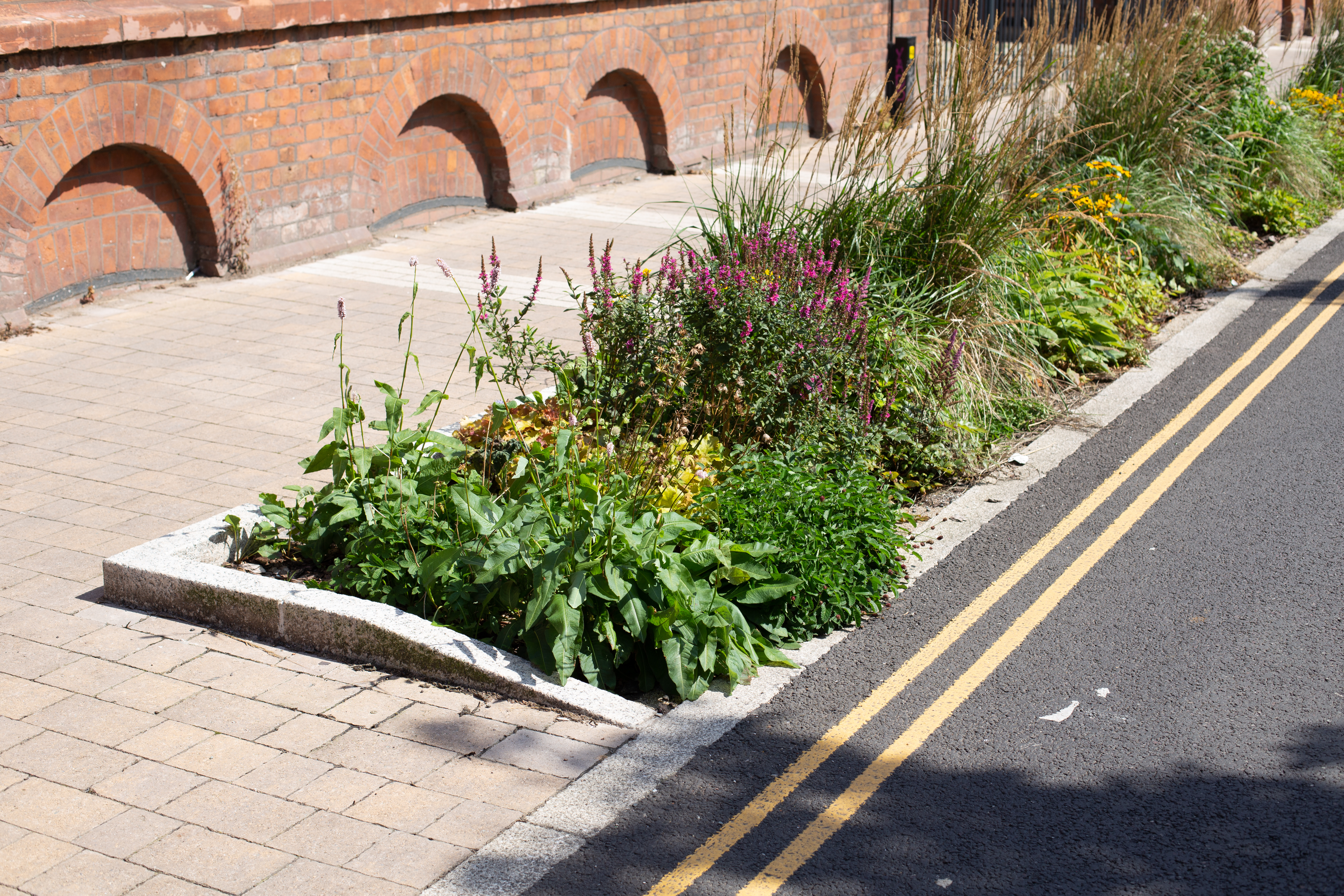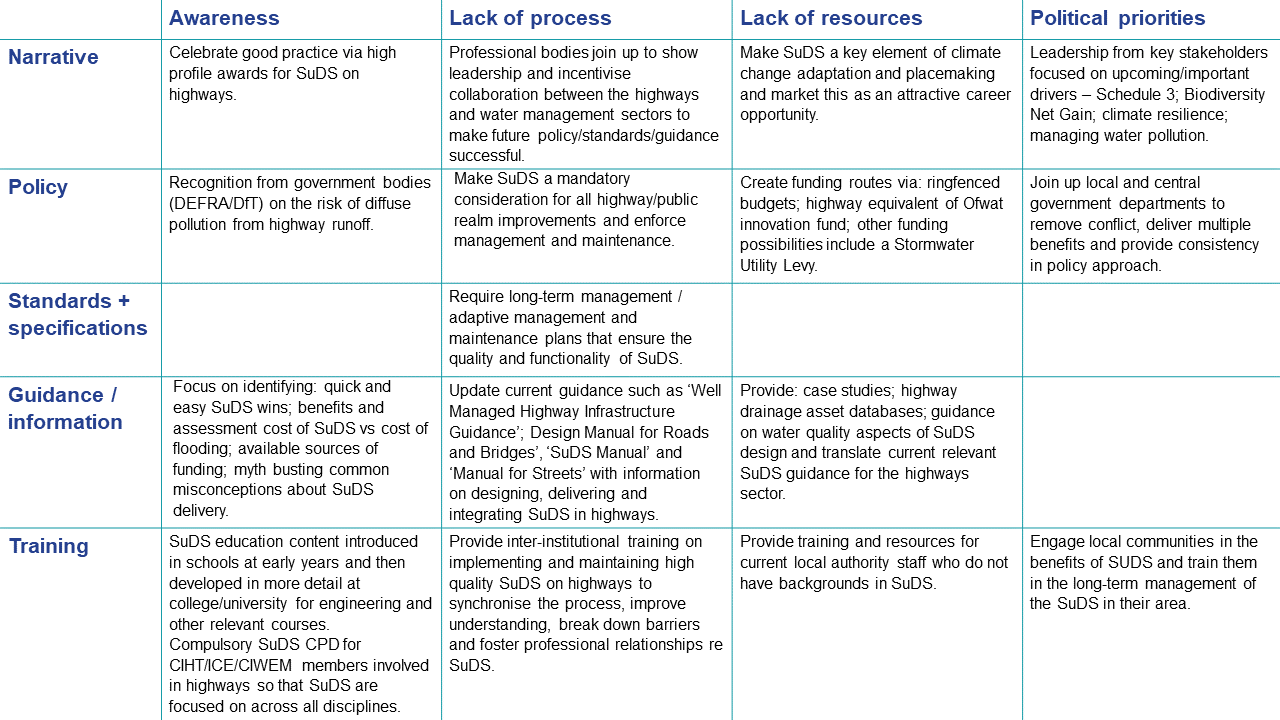
On 27 June, in partnership with the Chartered Institution of Water and Environmental Management (CIWEM), CIHT hosted a roundtable that sought to overcome challenges which currently hinder integrating Sustainable Drainage Systems (SuDS) on our highways.
Join other savvy professionals just like you at CIHT. We are committed to fulfilling your professional development needs throughout your career
SuDS are a feature of Green and Blue Infrastructure (GBI) that combine plants and soil with grey infrastructure e.g., pipes and sewer networks, to mimic natural drainage systems. The common types of SuDS that we find on our streets or adjacent to roads are rain gardens, swales and permeable paving.
SuDS are incredibly useful for managing surface water runoff (water that flows across land at a surface level) as close as possible to where it falls as rain. SuDS soak up and filter surface water before discharging runoff into watercourses or a drainage network (i.e., sewers). They can also be used to store water (either permanently or temporarily) in basins or underground tanks etc.
Having SuDS in place means that when it rains, surface water runoff is slowly transferred to streams, rivers and the sewer network, where it can be naturally cleaned instead of large amounts of contaminated water from our roads being washed into watercourses or flushed into drains and gullies, increasing the risk of erosion, flooding and pollution. As a nature-based solution, SuDS also create new attractive landscape features and habitats, increasing biodiversity and amenity in an area, as well as providing shade from heatwaves and improving local air quality.

In a recently published CIHT report on GBI we acknowledged that there is a mixed understanding of GBI within the transport sector, which leads to poor implementation and a poor realisation of the benefits of GBI features such as SuDS.
It was also recently recommended, in January this year, by the Department for Environment, Food & Rural Affairs (DEFRA) that SuDS should become mandatory to new developments in England from 2024, via the implementation of Schedule 3 of the Flood and Water Management Act 2010.
Schedule 3 provides a framework for the approval and adoption of SuDS, as well as and national standards on the design, construction, operation, and maintenance of SuDS for the lifetime of the development. It also makes the right to connect surface water runoff to public sewers conditional upon the drainage system being approved before any construction work can start.
It is not yet clear how implementation of Schedule 3 will affect the highways and transportation sector, with DEFRA seeking to confirm the details on how it will progress with this after a consultation later this year.
However, whether it becomes mandatory for SuDS to be implemented on roads or not, effective water management is crucial to the work of highway professionals. It is also important for us to consider how we can retrofit SuDS into existing towns and cities and increase biodiversity and climate resilience through sustainable interventions.
Bringing all this together, CIHT hosted a roundtable in partnership with the CIWEM to discuss the current challenges the highways sector faces when it comes to implementing SuDS and what solutions are needed to overcome them.
Before the roundtable, we asked our CIHT members and roundtable participants to list what they believed to be the biggest challenges in implementing SuDS on highways. We then grouped these into four areas, which were:
Due to a lack of awareness or understanding, many people believe that SuDS are:
When implementing SuDS there is a lack of:
There is currently not enough:
Sometimes, those wanting to implement SuDS struggle to balance:
During the roundtable, attendees were then asked to provide solutions to these challenges in terms of:
A summary of the group’s answers can be seen in the matrix below:


As discussions ensued between the roundtable attendees, four key messages stood out.
For SuDS to be successfully integrated in our highways there needs to be involvement across all disciplines – water management professionals, transport planners, engineers, landscape architects and asset managers. To break down siloes, and ensure we do not create new ones, the institutions that represent these professionals must collaborate to share information and synchronise the end-to-end process of designing and implementing SuDS.
Professional institutions can play a key role in enriching the understanding of their members around the benefits of SuDS. As such, options such as compulsory SuDS CPD for members was highlighted, alongside championing those who are leading on best practice (through awards and case studies).
There are many examples of project teams who have managed to utilise available funding routes to design and implement, or retrofit, high quality SuDS integrated with highways. By showcasing how these project teams achieved this and enabled maintenance, it will not only benchmark what is considered as high-quality SuDS but also share evidence to counter some of the common misconceptions around SuDS. Alongside immediate practical signposting, there was a clear message that membership bodies can play a key role in longer-term influencing around integrating SuDS into highways.
SuDS should be as important to the highways sector as they are to surface water management professionals. By focusing on upcoming political drivers and opportunities such as Biodiversity Net Gain and Net Zero, as well as wider benefits such as climate resilience and improving water pollution, the importance of SuDS should be messaged as a key solution to these upcoming challenges.
SuDS are also an unrecognised, yet useful, part of active travel infrastructure. By including SuDS such as rain gardens on streets with any highway improvement project, they become a more inviting and safer places for people to spend time - encouraging walking, cycling and other forms of active travel, thus reducing the public’s reliance on motorised vehicles.
The need to build an understanding of the benefits of GBI at an early stage in education, potentially schools was noted, (e.g., how trees can manage flooding or heavy rainfall) as an initial step to build awareness of SuDS. This could then develop into more detail as children progress to college and through to university level, with SuDS being included in engineering and transport planning courses etc., where training for highway engineers should encompass the essentials of hydraulic principles alongside elements such as landscape design and ecology.
If local communities understand the importance and benefits of SuDS they can advocate for them to be delivered in their neighbourhoods and potentially become involved in their maintenance. Not only will this alleviate some of the challenges around the political priority of local authorities, the negative perception of the public towards rain gardens and the long-term maintenance of SuDS, but it may also help to foster a sense of community, cohesion and amenity.
By making SuDS a key element of placemaking, ‘creating attractive neighbourhoods’ and climate adaptation –not only makes it an appealing career route – but one that demonstrates wider benefits to peoples’ wellbeing and sense of place.
For any press enquires please contact communications@ciht.org.uk
For any technical enquiries please contact technical@ciht.org.uk
Sign up to the APM Newsletter.
{{item.AuthorName}} {{item.AuthorName}} says on {{item.DateFormattedString}}: